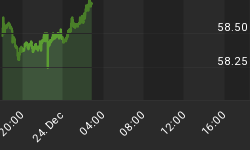Every investment product on planet earth is designed to at least offer a chance at a positive, real after-tax return. Put another way, all investments are designed to bring you a return that is greater than the rate of inflation. Some offer a higher stated yield because of their inherent risk, while others display smaller yields due to their perceived relative safety. But all true investments are designed to outpace inflation.
It is ironic, then, that the only true investment to ever bake in a negative return after inflation is Treasury Inflation Protected Securities -- ironic because the very purpose of TIPS existence, of course, is to provide for a guaranteed real return. In fact, TIPS recently yielded a negative return for the first time since their inception in 1997. The 5-year TIPS note ended February 29th at a -.043% and remained negative through most of the month of March.
Comparing TIPS to a genuine inflation hedge like gold reveals their ineptness as an inflation-protected product. Since President Nixon broke the gold window in 1971, gold has soared from roughly 35$ an ounce to $950 per ounce as of this writing. That equates to an annual return of 9.33%, while TIPS have returned an average annual rate of just 5.4% since 1997.
The standard five-year Treasury Note now yields 2.45%. Meanwhile, today's 5-year TIPS yield is only a slightly positive .07%, implying that investors' anticipated rate of inflation over the next five years is just 2.38%. That means investors expect a dramatic decline in inflation rates from the current "official" rate 4.1%-- which itself is likely understated. Such expectations are untenable given the actions taken by the government and Fed over the past 7 months.
In fact, today's inflation rates should escalate due to the current excessive rate of monetary creation. Money of Zero Maturity (MZM) is currently rising at an annualized rate of 36.8%, while the Fed Funds rate is at a historically low, inflationary level.
As most know, the Fed Funds target is currently 2.25% while the effective Federal Funds rate is now trading at 2.09%. Putting this rate in historic terms, the rate on the effective Federal Funds rate traded above 2.15% in January of 1962 and remained above that rate until November of 2001 when it declined to 2.09% for the first time in nearly 40 years.
Already, this key interest rate is back to the post-9/11, post dot-com "emergency level, a rate which of course engendered the now-defunct housing bubble and today's secular bull market in most commodities.
All the while, commentators from far and wide have been quick to call the recent commodities correction the actual bubble which has burst. Quite the contrary; given this inflationary monetary backdrop, it is time to take advantage of the recent pullback in precious metals. Investors need to place their money in a real inflation hedge, and that is gold.
I discuss TIPS, gold and more in my latest podcast, the Mid-Week Reality Check. Five minutes of sanity in an insane financial world!















